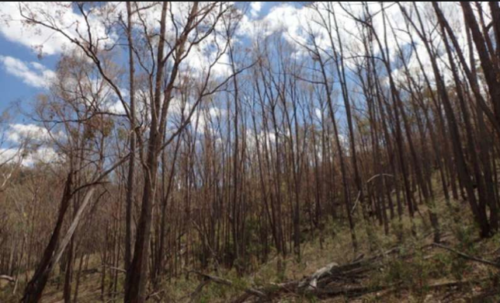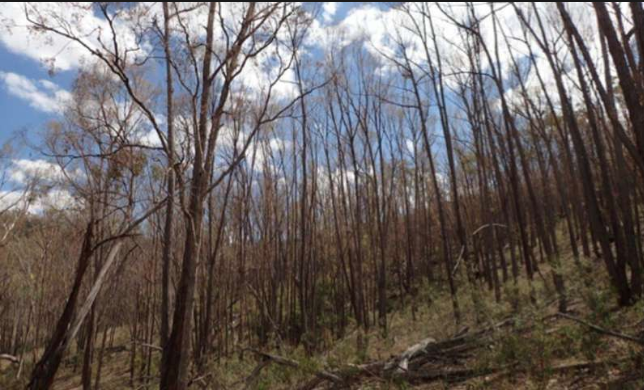 The current drought has had a major impact on trees on the tablelands and western slopes. In some areas tree canopies have wilted and browned off.
The current drought has had a major impact on trees on the tablelands and western slopes. In some areas tree canopies have wilted and browned off.
Sites most affected include rocky ridges and hillslopes with shallow soils with low water-holding capacity, typically on north or west facing slopes. As well, whole groves of river oaks on coarse sandy creek beds appear to have died.
Eddie Pook and co-workers from CSIRO studied impacts of the 1965 drought on trees in the ACT. They found that some eucalypts could withstand severe dehydration. However, protracted dry spells also dried out the trunks, causing them to shrink, sometimes leading to fissures that ultimately separated the bark from the sapwood. This killed the affected part of the trunk, which was then more susceptible to infestation by longhorn beetle larvae.
Many of the trees so-affected by drought are likely to recover, usually from shoots arising from the trunk and lower branches. However, some trees, particularly in the hills near Tamworth, which lost their foliage last year have again lost the recovering foliage. It is likely many will die.
Woodland trees on deeper soils with greater water-holding capacity have been largely spared such acute drought effects so far. Eddie Pook’s team measured the available water in roughly the top 2 metres of soil in areas of dry sclerophyll forest that were impacted by drought with that of unaffected areas of woodland and found that, when saturated, the woodland soils had 300 to well over 400 mm of water compared with just 40-80 mm for the dry sclerophyll forest soils.
I monitored several stands of trees that were affected by dieback during dry spells in the early 1980s. I found that trees most affected by dieback going into the drought were likely to die, whereas the crowns of trees that were in a fair condition at the start of the drought usually improved, probably because populations of defoliating insects crashed during the drought.
Our native trees tend to be well adapted to coping with dry spells, as long as they are not too protracted. Trees typically have a combination of shallow roots that can exploit light showers of rain and deep roots that tap into moisture deep underground. Drought-adapted eucalypt species can shed a lot of their foliage during excessively dry spells without long-term effects on their vitality, provided growing conditions return to normal in the following season.
By Chris Nadolny: The Armidale Tree Group
